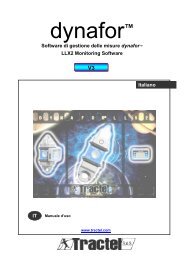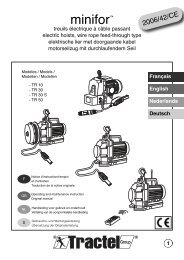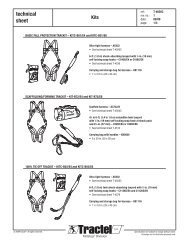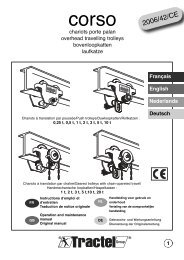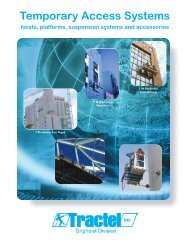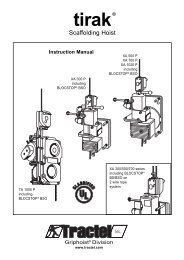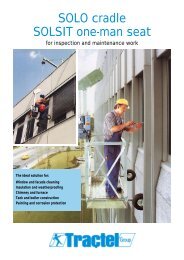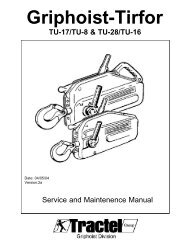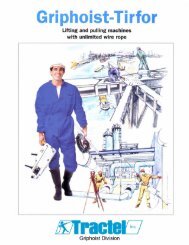Create successful ePaper yourself
Turn your PDF publications into a flip-book with our unique Google optimized e-Paper software.
<strong>The</strong> <strong>Mobile</strong> <strong>Winch</strong> <strong>with</strong> TIRAK ®for Material Transport<strong>with</strong> wire rope reeler for up to 80 m of wire rope storageOperating and Maintenance ManualThis manual must be available for the user at all times.Additional copies can be obtained on request.<strong>Mobile</strong> <strong>Winch</strong>SeriesMX 300 M/80MX 500 M/80MX 700 M/80<strong>Mobile</strong> <strong>Winch</strong>SeriesMT 1000 M/80Specification:Type: Serial No.: Delivery date:G 305-03/97 Printed in Germany © GREIFZUG GmbH 19971
ContentsPage1. Warning Advice 22. Machine-Description2.1 Purpose 22.2 Working principle 22.3 Main components and operating controls 32.4 Technical data 32.5 Wire ropes 32.6 Noise emission 33. Setting Up3.1 Required equipment 43.2 Transport 43.3 Mounting3.3.1 Choice of the anchor point 43.3.2 Increasing the capacity byreeving the wire rope 43.3.3 Anchoring the hoist 53.4 Electrical connections 64. Operation4.1 Electrical controls 64.2 Checks before starting 7Page4.3 Normal operation 74.4 Security of suspended loads 74.5 Emergency descent 74.6 Troubleshooting 85. Replacing the wire rope5.1 Preparation 95.2 Running out the wire rope 95.3 Wire rope installation 96. Out of operation6.1 Temporary stoppage 106.2 End of operation 107. Safety advice 108. Maintenance/Checks/Repair8.1 Maintenance 118.2 Checks 118.3 Repair 119. Spare parts order 12Declaration of Conformity 121. Warning AdviceFailure to follow all instructions contained in thismanual and all Safety regulations may result ininjury.Anchoring, maintenance, and/or operation of “<strong>Mobile</strong> <strong>Winch</strong>es<strong>with</strong> TIRAK ® ” must only be carried out by persons, who arefully trained and authorised to anchor, maintain, and/or operatethe winch by their employer.<strong>The</strong> operator should know and follow the employers safetyrules and worksite regulations as well as the manufacturersinstructions and safety rules in this manual.All “<strong>Mobile</strong> <strong>Winch</strong>es <strong>with</strong> TIRAK ® ”, wire ropes, anchoring pointsand other anchoring devices such as slings, pulleys etc. shouldbe inspected prior to use and in good condition.It is stressed that the TIRAK ® wire rope is not a standardproduction rope, and the manufacturer (or Group company)declines all responsibility and/or warranty claims if rope otherthan the prescribed TIRAK ® wire rope is used in the equipment.“<strong>Mobile</strong> <strong>Winch</strong>es <strong>with</strong> TIRAK ® ” must not be overloaded.<strong>The</strong> manufacturer (or Group company) declines all liability fordamages caused by either modifications or alterations of thewinch, other than those carried out by the manufacturer, or theuse of non-original spare parts.2. Machine Description2.1 Purpose<strong>The</strong> “<strong>Mobile</strong> <strong>Winch</strong> <strong>with</strong> TIRAK ® ” is a portable, electricallydriven hoist for lifting, lowering, and pulling of loads by meansof a TIRAK ® wire rope recommended by the manufacturer.This wire rope is mandatory for the safe and troublefree working<strong>with</strong> the “<strong>Mobile</strong> <strong>Winch</strong> <strong>with</strong> TIRAK ® ”.2.2 Working principleProvided that the “<strong>Mobile</strong> <strong>Winch</strong> <strong>with</strong> TIRAK ® ” is aligned indirection of pull, it will work in any position and in any direction.For either lifting or lowering there is one corresponding pushbutton. <strong>The</strong> wire rope is driven through the hoist <strong>with</strong> constantlyeven safety and is stored in the rope reeler. <strong>The</strong> reeler isautomatically driven by the in-running resp. out-running wirerope.<strong>The</strong> “<strong>Mobile</strong> <strong>Winch</strong> <strong>with</strong> TIRAK ® ” of MT 1000 series <strong>with</strong> acapacity of 1000 kgs is complete <strong>with</strong> a pulling force limitingdevice.MAN-RIDING is not allowed,unless the following conditions are met:– <strong>The</strong> “<strong>Mobile</strong> <strong>Winch</strong> <strong>with</strong> TIRAK ® ” winch must besuitable for man-riding, and– A secondary fall arrest device, operating on aseparate safety wire rope must be provided;the Primary and Safety rope must not be attachedto the same anchor point, and– the Man-riding installation and suspension systemmust comply <strong>with</strong> all relevant Safety Regulationsin force for such installations.Where a TIRAK ® machine is used as part of a suspendedaccess system the manufacturer of the system isresponsible for the design and construction of the system.<strong>The</strong> user is responsible for the safe use of theequipment having read and understood the instructionmanual(s) supplied by the manufacturer.2
2.3 Main components and operating controlsFig. 1MX 300 M/80MX 500 M/80MX 700 M/804761 TIRAK2 Frame3 Anchoring device4 Wire rope reeler5 Pendant control6 Upper limit switch7 Wire rope end detectorand reeler survey switch8 Wire ropeMT 1000 M/804781235bca8 61232.4 Technical DataDesign according to DIN 15 020,transmission group 1 B m.Technical modifications reserved.<strong>Mobile</strong> Wire Type TIRAK DeadRatedDimensionswinch <strong>with</strong> Capacity rope of Output rope weightcurrentTIRAK ® speed drive Ø approx. a b cSeries kgs 1) m/min – 2) kW A mm kgs 3) mm mm mmMX 300 M/80 300 9 D 0.5 1.6 8 50 615 430 48018 D 0.9 3.09 W 0.5 4.8MX 500 M/80 500 4.5 D 0.5 2.0 8 70 715 480 5409 D 0.9 2.84.5/9 D 0.5/0.9 2.9/3.04.5/18 D 0.5/1.8 2.0/5.09/18 D 0.9/1.8 3.6/5.89 W 0.85 6.5MX 700 M/80 700 4.5 D 0.75 3.2 8 75 715 480 5409 D 1.5 3.94.5/9 D 0.75/1.5 3.0/3.94.5/18 D 0.75/3.0 3.6/8.29/18 D 1.5/3.0 4/89 W 1.5 9.5MX 1000 M/80 1000 4.5 D 0.9 3.7 8 110 750 510 5609 D 1.9 4.64.5/9 D 0.9/1.9 3.6/4.64.5/18 D 0.9/3.6 4.0/9.79/18 D 1.9/3.6 5.5/9.51) If the capacity is not sufficient in direct pull, multiply it by reeving the ropeaccording to the block and tackle principle. Details on page 4.2) D = 400 V three phase; W = 230 V single phase.3) <strong>with</strong>out wire rope2.5 Wire Ropes2.6 Noise emission (at 1m distance)Diameter:Construction:Equipment:Marking:Weight:8 mm (see ferrule)non rotatingSwivelling hookOne core red colored0.25 kg/mGB8DIN“<strong>Mobile</strong> <strong>Winch</strong> <strong>with</strong> TIRAK ® ”TypeMX 300 P/80: ................................................. max. 72 dB(A)MX 500 P/80,MX 700 P/80 undMT 1000 P/80: .............................................. max. 70 dB(A)3
3. Setting up3.1 Required equipmenta) “<strong>Mobile</strong> <strong>Winch</strong> <strong>with</strong> TIRAK ® ” of correct capacity.b) TIRAK ® wire rope <strong>with</strong> correct diameter and of sufficientlength.c) Electric supply cable of correct type and required length,<strong>with</strong> sufficient leads cross sectional area.d) Anchoring devices for fixing both the hoist and the load(i.e. slings, belts or similar) of sufficient strength.e) Pulleys (if required) for diverting or reeving the wire rope ofsufficient strength and diameter.f) Oil to lubricate the wire rope.Anchoring examples:LiftingFig. 2 Fig. 3Thoroughly inspect all equipment to ensure there are nofaults!3.2 Transport<strong>The</strong> “<strong>Mobile</strong> <strong>Winch</strong> <strong>with</strong> TIRAK ® ” can be carried by its frame.For the transport by crane fasten slings or similar carryingdevices to the frame.3.3 MountingFig. 4Pulling3.3.1 Choice of the anchor pointa) <strong>The</strong> anchor point (Fig. 2 and 4) resp. the wall/ceiling (Fig.3/3a ) must be checked by a competent person to ensureit is of sufficient strength to take the load and any shockload imposed.b) If you want to lift/pull through anopening in the wall or ceiling capableof taking the load, simply sitethe “<strong>Mobile</strong> <strong>Winch</strong> <strong>with</strong> TIRAK ® ” byor above the hole (Fig. 3).If the hole is not big enough for therope hook to pass through, positionthe “<strong>Mobile</strong> <strong>Winch</strong> <strong>with</strong> TIRAK ® ” andpass the wire rope through the holeFig. 3aand then into the hoist (Fig. 3a).Details for wire rope installation seechapter 7, on pages 8/9.Fig. 52·F!3·F!Diversiononly!Lifting3.3.2 Increasing the capacity byreeving the wire ropeF2·FIf the capacity of the “<strong>Mobile</strong> <strong>Winch</strong> <strong>with</strong> TIRAK ® ” is not sufficientin direct pull, it can be multiplied by reeving the wire ropeaccording to the block and tackle principle (Fig. 5).But double capacity means half speed.ATTENTION! A competent person must check –a) that the pulleys and the anchoring devices as wellas all anchor points are of sufficient strength, andb) that the pulleys are of the correct diameter.Important for horizontal pull:Do not confuse the dead weight of the load <strong>with</strong> theeffort required to pull it: the TIRAK ® has only to overcomethe friction coefficient.Explanation: F means the TIRAK ® capacity –e. g. F = 500 kgs.<strong>The</strong> drawings show the required strength of theanchor points, anchoring devices, and pulleys –e. g. 2·F = 1000 kgs.FFFPullingF2·F4
3.3.2 Increasing the capacity …(continued)TIRAKFrameFig. 6Attention!With the wire rope reeved the upper limit switch cannotbe activated by the fist grip clip, which is mountedon the rope near the rope hook.<strong>The</strong> operator has to watch the load very carefully orhave it watched by a second person.<strong>The</strong> rope hook must not reach the diverter pulley!SlingSafety pinAnchor bolt3.3.3 Anchoring the hoistFig. 7(A) Anchoring <strong>with</strong> a sling, belt or similarOpposite to the wire rope entry the TIRAK frame contains ananchor bolt (Fig. 6). Use it for anchoring the “<strong>Mobile</strong> <strong>Winch</strong><strong>with</strong> TIRAK ® ” to an appropriate anchor point.Attention!– Check the correct position of the safety pinaccording to Fig. 7!– <strong>The</strong> “<strong>Mobile</strong> <strong>Winch</strong> <strong>with</strong> TIRAK ® ” must be ableto align itself in pulling direction (Fig. 8).– Maximum allowable deviation fromsquareness is 5° (Fig. 9). If necessary usediverter pulleys (Fig. 2).Attention!When using diverter pulleys the upper limit switchcannot be activated by the rope clamp, which is mountedon the rope near the rope hook.<strong>The</strong> operator has to watch the load very carefully orhave it watched by a second person.<strong>The</strong> rope hook must not reach the diverter pulley!Fig. 8Fig. 9max. 5°Fig. 10(B) Positioning by/above an opening in the wallor ceiling capable of taking the loadAttention!– <strong>The</strong> wire rope must be able to freely run in andout!– Secure the “<strong>Mobile</strong> <strong>Winch</strong> <strong>with</strong> TIRAK ® ” againstbecoming displaced!Wire rope inlet/outlet5
3.3 Electrical Connectionsa) Ensure that the mains voltage is adequate for the motorof the TIRAK ® –– Three phase:400 V (3P + E + 0), 50 Hz,16 amp rated plug and socket– Single phase:220 V (2P + E), 50 Hz,16 amp rated plug and socketIf in doubt ask.b) To avoid power loss between power source and the TIRAK ®always use power cables <strong>with</strong> adequate cross sectionalarea. See Tables 1a and 1b.Table 1aindicates the reference letter of the TIRAK ® model andthe mains supply voltage.Maximum speed must be used for TIRAK ® <strong>with</strong> twospeeds.Table 1bgives the minimum cable cross section based on thereference letter.c) Use only heavy duty cables <strong>with</strong> incorporated strainrelief.d) Hanging cables longer than 30 m should be fixed bymeans of a cable sleeve or cable clamp.e) When using a generator its output must be at least 2.5times greater than the TIRAK ® power consumption.Table 1a<strong>Mobile</strong><strong>Winch</strong> seriesMX 300 P/80MX 500 P/80MX 700 P/80MT 1000 P/80Reference letter of table 1aMax.speedm/min.1 TIRAK 2 TIRAK3 phases S. ph. 3 phases S. ph.400V 230V 230V~ 400V 230V 230V~9 A B C A D F18 A C - B F -9 A C E B F G18 B E - D G -9 A - G B - -18 B - - D - -9 B E - D G -18 C G - F H -For cable lengths up to ...20 m 50 m 100 m 200 mA 1,5 1,5 1,5 1,5B 1,5 1,5 1,5 2,5C 1,5 1,5 1,5 4D 1,5 1,5 2,5 4E 1,5 1,5 2,5 6F 1,5 1,5 4 6G 1,5 2,5 6 10H 2,5 6 10 20Table 1b 0 Cross section (mm 2 )4. Operation4.1 Electrical ControlsPush button control for UP and DOWN (Fig. 11).On machines <strong>with</strong> two speed motor:half depressed = low speedfully depressed = high speed.Fig. 11Pendant control for1 speed 2 speedsDO NOT fix push buttons in run position.Red EMERGENCY-STOP button:Button depressed = mains supplyinterrupted.To START, turn red EMERGENCY-STOP button clockwise,until it releases.EMERGENCYSTOPUPDOWNImportant: <strong>The</strong> built-in phase control relay preventsthe motor from turning in the wrong direction. If thehoist does not run, turn the phase inverter of the plugfor 180°, or let a qualified electrician exchange theleads of two phases inside the hoist plug.6
4.2 Checks before startinga) Check that the UP/DOWN push buttons and EMERGEN-CY-STOP button are working correctly.b) Check correct anchoring of “<strong>Mobile</strong> <strong>Winch</strong> <strong>with</strong> TIRAK ® ”and load.c) Make sure that no person is immediately below the suspendedload.4.3 Normal Operationa) To lift/pull: depress the UP button.To lower: depress the DOWN button.b) TO STOP movement of the load:A) release push button;if the load does not stop:B) press EMERGENCY-STOP;if that does not function:C) pull out the plug!In cases B) and C): STOP working. <strong>The</strong> “<strong>Mobile</strong> <strong>Winch</strong><strong>with</strong> TIRAK ® ” must be checked/repaired by the manufactureror a repairshop agreed by him.c) Attention must be paid to the load during all movements– if necessary by a second person.d) Keep wire rope lightly lubricated.e) When lifting/lowering prevent the load from rotating(Fig. 12).f) When stopping the hoist the load is securely held at anyposition by the primary brake.Fig. 124.4 Security of suspended loadsCordon off the danger zone below any suspended load.4.5 Emergency DescentFig. 13(principle drawing)In case of power failure you can manually open the brake onhoists which are equipped for this purpose:– Take the control lever from the TIRAK ® carrying handle,insert it through the motor cover into the brake releasepoint and push it in arrow direction (Fig. 13).– With the brake released the load is lowered, and the centrifugalbrake limits the speed of descent.To STOP: release the control lever.After use: Restore brake release lever into its rest.Brakerelease leverCarryinghandleTop view of “<strong>Mobile</strong> <strong>Winch</strong> <strong>with</strong> TIRAK ® ” ofMX 300 to 700 M/80 series.On MT 1000 M/80 series the motor is located atthe right side, in consequence push brake releaselever to the right.7
4.6 TroubleshootingWARNING!AVOID INJURIES:1. Checks an repairs of the electrical equipment must only be carried out byqualified electricians! Wiring diagrams are shown in the control box of themotor.2. Any other repairs should only be carried out by the manufacture or by a repairshop agreed by him. And only original spare parts shall be used.4.6.1 Wire Rope Drive Mechanism TroublesProblem Cause Remedy<strong>The</strong> hoist operates,but the wire rope does notmove through, i.e.no UP or DOWN travel.Damagedwire rope,wrong wire rope,orobstructed wirerope exit.WARNING!STOP OPERATIONS IMMEDIATELY!Continued operation the “<strong>Mobile</strong> <strong>Winch</strong> <strong>with</strong> TIRAK ® ”might cause breakage of wire rope!CONTACT YOUR SUPPLIERYou may continue your job proceeding as follows:– If available, install an auxiliary hoist, and take over the load<strong>with</strong> that hoist.– Disconnect the load from the slack wire rope of the failed hoist.– Continue the work <strong>with</strong> the newly installed hoist.4.6.2 Troubles <strong>with</strong> Motor, Control or BrakeProblem Cause Remedy1. Motor doesnot runat all.2. Excessivemotor noise3. Overheating4. AbnormalnoisesUpper limit switch has cut offlifting/pulling.Wire rope end detector hascut off lowering/releasing.Reeler survey switch has cutoff lowering/releasing:– pinched wire ropeinside the reeler– damaged wire ropeNo problem – lowering/releasing the load is possible.No problem – lifting/pulling the load is possible.If requested install longer wire rope (max. 80 m).In most cases the pinched wire rope will be freed by shortly pushingthe UP-button one or two times.If not, replace the hoist (s. above) and have it repaired.Attention: if the wire rope runs out again, check for damages,which may have caused the problem, e.g. a broken,protruding wire. In that case install new wire rope.Phase inversionCurrent failureOverheating– Insufficient cooling– OverloadPulling force limiting deviceof MT 1000 P/80 has stoppedlifting/movingTurn phase inverter inside the plug for 180°, or let a qualifiedelectrician exchange the leads of two phases inside thehoist plug.Check fuses, power cords, connections and(on single phase machines only) starting capacitor.Let the motor cool down.Trace the reason for overheating:– Clean air inlet at the motor cover, and ensure a good ventilationof the motor.– Check the load. If necessary reduce the load or use multiplesheave blocks (see chapter 3.3.2 on page 4).Brake does not open (missing clicking, noise when starting/stopping the winch)– current failure, defect – Let a qualified electrician check connections, brake coil,brake coil or rectifier and rectifier, and exchange if necessary.– Worn brake lining – Let the winch be repaired.If the above checks and actions do not overcome the problem:CONTACT GREIFZUG GmbH or a repair shop agreed by him.8
5. Replacing the wire ropeFig. 145.1 PreparationCAUTION!Use gloves, when handling wire ropes.a) Use only prescribed TIRAK ® wire ropes (see chapter2.5, page 3).b) Check correct diameter and sufficient length of the wirerope.Fig. 15Safety catchc) Always unreel the wire rope in a straight line (Fig. 14), toprevent it from becoming unusable because of loops.d) Check the condition of the wire rope for damage:– swivelling hook is not bent; safety catch is in place onthe hook; proper connection between the wire rope andthe hook (rope eye, ferrule) (Fig. 15);SwivellinghookRope eyeFerrule <strong>with</strong>rope-Ø marking– the wire rope has no visible damage along its totallength; the fused and tapered end is according to Fig. 16.e) Check the wire rope equipment (Fig. 17/18):Fig. 16– Fist grip clip for upper limit switch activation,– Limit switch activating spring,– two set collars for wire rope end detector activation.max.2 ØØFig. 175.2 Running out the wire ropeFist grip clipLimit switchactivating springa) Press DOWN-button to let the wire rope run out, until thewire rope end detector stops the motor.b) Turn service hole of the reeler to the wire rope entry. PressUP-button to let the wire rope end run out of the servicehole (Fig. 18).c) Loosen both set collars <strong>with</strong> a 4 mm Allen key and pull offthe wire rope end.d) Press DOWN-button to let the wire rope run out.Fig. 18min.10 cmSet collare) Take off fist grip clip and limit switch spring.Important: Keep fist grip clip and limit switch springat hand – You need them when installing the new wirerope!Service holeRope reeler(Principle sketch)5.3 Wire rope installationa) Slide the limit switch spring onto the wire rope tip(Fig. 17).b) Feed the wire rope as far as possible into the wire ropeentry guide of the upper limit switch.c) Press UP-button, and push the wire rope, until it starts toreeve itself automatically.d) If it will not reeve, check:– Wire rope tip in correct shape?– Did you press UP-button?e) STOP, when the wire rope tip enters the rope reeler.f) Turn service hole to the wire rope entry. Guide the wirerope out of the service hole, and press UP-button, until youcan reach it for set collar installation.CAUTION!g) Slide both set collars for wire rope end detectoronto the wire rope and fix them at aminimum distance of 10 cm from the wirerope tip (Fig. 18). Tighten set collar screws<strong>with</strong> a 4 mm Allen key.If You do not, the wire rope could inadvertently run out andthe load fall down!h) Put wire rope tip back into the reeler and continue <strong>with</strong>running in the wire rope, it automatically stores itself insidethe reeler.i) Fix fist grip clip for upper limit switch activation to thewire rope between the ferrule and the limit switch spring(Fig. 17).9
6. Out of Operation6.1 Temporary Stoppage– Disconnect power supply, to prevent any unauthorizedoperation:– Disconnect power cord at the hoist pigtail as well as thethe main outlet and, if available,– turn and lock the main switch to „0”.– Cordon off the danger zone below any suspended load.6.2 End of Operation– Let the wire rope completely run in.– Disconnect power cord at the hoist pigtail as well as themain outlet; check for any damage and reel the cable.– Disconnect the “<strong>Mobile</strong> <strong>Winch</strong> <strong>with</strong> TIRAK ® ” from its anchorpoint.– Clean the exterior and store it in a clean and dry place.7. Safety advicea) DO NOT overload the “<strong>Mobile</strong> <strong>Winch</strong> <strong>with</strong> TIRAK ® ”.b) DO NOT stand below a suspended load.c) <strong>The</strong> “<strong>Mobile</strong> <strong>Winch</strong> <strong>with</strong> TIRAK ® ” must only be used forlifting, pulling, and lowering of loads. Use for other purposesis not allowed.d) Use only prescribed TIRAK ® wire ropes in good condition.e) Anchoring, maintenance, and/or the operation of the “<strong>Mobile</strong><strong>Winch</strong> <strong>with</strong> TIRAK ® ” must only be done by persons,who are familiar <strong>with</strong> it. <strong>The</strong>y must have obtained the orderto anchor, maintain, and/or operate the hoist by the employer.f) <strong>The</strong> operator has to know and to follow all relevant localsafety regulations, and maintenance recommendations, aswell as this operating instruction, and the operator has tohave been instructed.g) <strong>The</strong> operator must not start any movement of the load untilhe has checked that the hoist and the load are properlyanchored, and that no person is stood in the danger zonebelow any suspended load, or until he has got a startingsignal from the slinger.h) <strong>The</strong> operator must watch the load during all movementoperations of the hoist.If the operator is unable to watch the complete workingarea, the danger zone must be cordoned off, or a secondperson must be positioned to enable the complete workingarea to be watched and have adequate means of communication<strong>with</strong> the hoist operator during the whole operation.h) <strong>The</strong> “<strong>Mobile</strong> <strong>Winch</strong> <strong>with</strong> TIRAK ® ” has to be either anchoredat the anchor bolt or located behind/above a solid structure,capable of taking the load, <strong>with</strong> its frame at the wirerope entry side.i) <strong>The</strong> “<strong>Mobile</strong> <strong>Winch</strong> <strong>with</strong> TIRAK ® ” has to be anchored insuch way, that the deviation from squareness of the wirerope under load does not exceed 5°.k) <strong>The</strong> wire rope reeler must always be able to free-running.l) Do not use the wire rope to fix the load, and do not pull itover sharp edges.m) DO NOT use the hoist <strong>with</strong>out two set collars installed onthe wire rope end inside the reeler.n) Near the ferrule of the hook there must be fixed a fist gripclip for upper limit switch activation. Never let the fist gripclip be pulled towards the ferrule.o) Install limit switch spring between fist grip clip and ropeinlet.p) In case of wire rope reeving the upper limit switch cannotbe activated by the fist grip clip.<strong>The</strong> operator has to watch the load very carefully or haveit watched by a second person.<strong>The</strong> rope hook must not reach the diverter pulley!q) DO NOT use the “<strong>Mobile</strong> <strong>Winch</strong> <strong>with</strong> TIRAK ® ” <strong>with</strong> standardelectric equipment 1) in a potentially explosiveatmosphere – around distilleries, refineries, chemicalplants, ship or silo interiors. Always obtain official approvalbefore commencing operations at these or similar locations.1) Contact GREIFZUG GMBH for a PNEUMATIC “MOBILEWINCH WITH TIRAK ® ”.10
8. Maintenance/Checks/Repair8.1 Maintenance8.1.1 Wire rope conveying mechanism<strong>The</strong> mechanism does not require any special maintenance.Lubrication: Keep the wire rope lightly lubricated. This will notaffect the gripping power but will prolong the life of wire ropeto a maximum.Fig. 19 (principle sketch)wire rope tipset collarrope reeler8.1.2 Wire rope reeler/guiding (Fig. 19)a) Keep rope reeler clean and take care that it is always freerunning.b) Keep rope guide spring clean.c) Keep activating tube of the wire rope end detector/reelersurvey switch clean, and regularly apply grease.<strong>The</strong> tube must be easy-sliding – check by hand.activatingtuberope guidespringswitch8.1.3 Wire ropesa) Always unreel and reel the wire rope.b) Do not use the wire rope for fixing the load, and do not pullit over sharp edges.c) Keep the wire rope always clean and lightly lubricated.8.1.4 Motor, Brake, and Gear Boxa) <strong>The</strong> motor does not require any special maintenance.If it is very dirty, it should be cleaned to ensure an effectiveair flow.b) <strong>The</strong> Brake does not require any special maintenance.If it is very dirty, it should be cleaned.Keep it free of oil or grease!c) <strong>The</strong> gear box is maintenance-free.<strong>The</strong> oil should be changed when carrying out a safetyinspection according to section 8.2.2.8.2 Checks8.2.1 Essential checksa) GeneralPrior to every operationandduring operation make sure, that the “<strong>Mobile</strong> <strong>Winch</strong> <strong>with</strong>TIRAK ® ” and all other used equipment (anchoring devices,pulleys etc.)– are properly installed– and <strong>with</strong>out visible damage.Attention!If during operation damage appear:– STOP operating,– if necessary: cordon off the danger zone ,and– let the damage be removed!b) Wire RopesAttention!Wire ropes should be checked along their entire lengthbefore every operation and replaced if any one ofthe following defects is noticed:– 10 or more broken wires along any length of 30times the diameter of the wire rope.– Excessive external or internal corrosion .– Heat damage, externally recognised by discoloration.– Reduction of the wire rope diameter by 5 % or morecompared to the nominal diameter.– Exterior deformations* ) of the wire rope like birdcaging,kink or loop formation.*) <strong>The</strong>se are only examples of the most common wire ropedamage. Maintenance and safety checks of the wire ropemust be done according the safety regulations in force.8.2.2 Safety InspectionControl by a competent person:1. <strong>The</strong> “<strong>Mobile</strong> <strong>Winch</strong> <strong>with</strong> TIRAK ® ” should be thoroughlyexamined at least every twelve months or more regularly(see 2 below) depending on the working practice and currentsafety regulations in force.2. <strong>The</strong> “<strong>Mobile</strong> <strong>Winch</strong> <strong>with</strong> TIRAK ® ” should be thoroughlyexamined at the latest after 500 running hours (for winches<strong>with</strong> 18 m/min. speed after 250 running hours).8.3 RepairIt is the responsibility of the employer that awritten register is kept showing the dates andperiod of use and inspection record.Repair of “<strong>Mobile</strong> <strong>Winch</strong>es <strong>with</strong> TIRAK ® ” must only becarried out by the manufacturer, or by a qualified person,and only original spare parts shall be used.11
9. Spare parts9.1 Wire rope drive mechanismAs well as spare part number and description please alwaysquote– TIRAK ® type– wire rope diameter, and– Serial N o !9.2 Motor and BrakeAs well as spare part number and description please alwaysquote– Motor typerespectively– Type and supply voltage of the brake!9.3 Electrical ControlsIn case of enquiries or spare parts order please always quotetheWiring Diagram N o !<strong>The</strong> Wiring diagram is situated in the control box of the motor.9.4 Nameplates and LabelsMake sure that all nameplates and labels are in place and notobscured (s. Fig. 20).Replace missing labels and those which are not legible!Fig. 20FIAGCDA) Label „Capacity”B) TIRAK ® Nameplate <strong>with</strong> serial N oC) Motor NameplateD) Brake NameplateE) Label „Set collar on wire rope tip”F) Label „Wire rope Ø”G) Label „Emergency descent”H) Label „Phase control relay”I) Label „Fist grip clip + Limit switch spring”FIAEHBEHCDGSpare parts lists are availablefrom your supplieror from GREIFZUG GmbH.BDEKLARATIONOF CONFORMITYGreifzug Hebezeugbau GmbHD-51434 Bergisch Gladbach, Postfach 20 04 40,represented by Mr. Clemens Vedova, MBA Insead,General Marketing Manager, declares that:<strong>The</strong> equipment described below conforms tothe technical safety rules, which are applicablefor the supply to the European Union market.SignatureAPPLICABLE REGLEMENTATIONS:EUROPEAN DIRECTIVES:N° 89/392 – 91/368 – 93/44 – 93/68N° 89/336 – 92/31EUROPEAN STANDARDS:N° EN 292 – EN 418 – EN 60204-1N° EN 50081-1 – prEN 50082-1GERMAN STANDARD:UVV “Winde, Hub- und Zuggeräte (VBG 8)”DESCRIPTION: Electric driven endless winchAPPLICATION: Lifting, lowering and pullingof loadsMAKE: <strong>Mobile</strong> <strong>Winch</strong> <strong>with</strong> TIRAK ®TYPE: MX 300 P/80, MX 500 P/80,MX 700 P/80, MT 1000 P/8012



